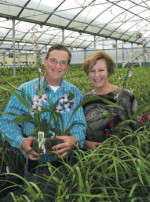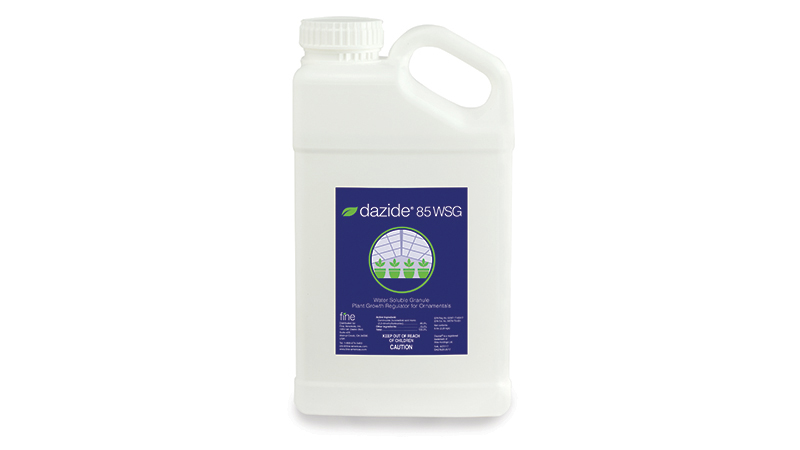Back To Basics

Mitch and Patty Rabin know in tough economic times, it’s best to stick with what you know. The duo, who are partners in life as well as in business, have streamlined their business–Living Colors Nursery in Homestead, Fla.–to focus primarily on their bread and butter: guzmania bromeliads.
When the operation started in 1993, they had the idea of selling guzmania bromeliads along with orchids. The orchid production had to wait several years, though, until they could find the proper tissue culture labs to work with and receive quality young plants. They found a variety of quality labs over the years, despite the challenges of cloning Phalaenopsis orchids, and offered many options in color and form. In the 1990s, they even worked with a California breeder to start a line of seedling Phalaenopsis orchids in art shades–new shades from the traditional colors that had dominated the marketplace at the time. From that, they worked to develop a line of cloned Phalaenopsis.
“There were some bumps along the road but it did develop into a really nice program,” Mitch Rabin says. “And I think that was an exciting time, too, because there was a lot of discovery. It was actually quite costly … but there are still plants in the marketplace today that came out from that program. It was kind of a fun time.”
But with changes in the economy and the distribution of orchids (with more coming from Asia in growing media thanks to relaxation of quarantine standards), the Rabins decided it was time to get back to basics. “Supply has changed, as demand has gone down with the current economic situation,” Mitch notes, and Patty says the quality of the varieties coming from tissue culture labs remains a challenge.
Back To Bromeliads
So Living Colors Nursery is returning the focus to guzmania bromeliads and a few other key, unique plants. Guzmania bromeliads are fickle, though. They take between 13 to 14 months to grow and only have a two-week window to sell. What’s more, they only bloom once, so if they’re not about to flower on delivery, they’re pretty much shot.
“It’s definitely a longer term crop and a bigger investment,” Patty says. To aid in the growing process, Living Colors Nursery has two greenhouses (totaling 80,000 square feet) and five shade houses (300,000 square feet), with an area in a greenhouse dedicated to packing and shipping. Guzmania bromeliads are sensitive to humidity conditions, so the greenhouses feature computerized environmental control systems to regulate humidity. They are also water quality sensitive, liking water that’s a little acidic with no minerals. So Living Colors Nursery uses water processed through reverse osmosis to ensure the plants thrive in the greenhouse.
The nursery also uses an integrated pest management program to reduce the amount of chemicals used and balance it out with scouting reports and other methods of pest control.
Because the plants are grown in the greenhouse, then outside under shade cloth, they’re exposed to the elements. The Rabins use European peat moss in the pots to give the plants some air space, even through the rainy season. They pull blooming plants into the staging area and give them enough time to dry out before shipping, so customers get the best possible product.
Living Colors sells to interiorscapers, wholesalers, brokers and independent garden centers, and ships 25,000 units in 4-, 6- and 8-inch pots monthly. That amount of diversity and volume requires a heavy focus on the individual needs of customers to ensure everyone is happy. ECGC, an alliance of 11 very powerful independent garden centers across the country, bestowed Living Colors Nursery with its Award of Distinction in 2004 and again in 2008 for top-notch customer service.
“We believe that an elevated level of customer service and exceptional product quality are what makes us successful, regardless of the economic climate,” says Lisa Phillips, sales manager at Living Colors Nursery. “To be recognized by ECGC, whose members are at the absolute peaks of their markets, motivates us to become even better at what we do.”
Catering To Clients
The Rabins and their sales staff have started to adapt the business via increased digital communications, enhancing availability with eMails, photos and surveys to the customers. “In the last four to five months we have really turned the corner and jumped into the 21st century to increase the overall information network that we can provide to our customers,” Patty says. “It really has made a big difference; our customers are responding much better to what we’ve done in the last four months than what we’ve done over the last 15 years.”
Living Colors Nursery also will go the extra mile to customize arrangements, and they’ve even helped with a wedding in the past. With a 32-person operation, they’re flexible enough to meet customer demands no matter how unusual.
And just like the name suggests, the nursery features a mix of guzmania bromeliads in more than 20 different colors via tissue culture labs from all over the world, as well as a handful of orchid varieties and some other unique offerings. One of the newest plants available through Living Colors Nursery is a crested Euphorbia with the common name Dragon Bones (Euphorbia lactea).
“Even today the excitement of not just bromeliads and orchids (but other plants, too) excite both of us a lot,” Patty Rabin says. “We love looking, learning and seeing beautifully landscaped gardens and places–we just get a real thrill out of it.”
How It All Began
Mitch has been enamored with bromeliads ever since he encountered them on a family trip to Costa Rica after high school.
His grandmother had planted the seeds for a love of horticulture years before with her collection of indoor potted plants and constant cuttings and young plants around the house. Combine those experiences with a “place of discovery” called Fantastic Gardens in Miami, and you have a recipe for a future grower that was inevitable.
Patty also has roots in horticulture, starting out with a two-year degree in landscape technology, then working at multiple garden centers in the Miami area. She met Mitch when she was the buyer and manager at Natureland Garden Center in Miami. Mitch was delivering plants for his business, Plants In Design. In November, they celebrated 20 years of marriage and 15 years in business.
“Patty and I sometimes remind each other that we’re happy and blessed to be producing something of beauty,” Mitch Rabin says. “We’re kind of lucky we have a product that, for the most part, makes people smile.”









